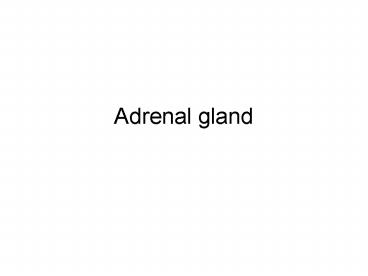Adrenal gland - PowerPoint PPT Presentation
Title:
Adrenal gland
Description:
Adrenal gland Anatomy Components Two compartments Adrenal Cortex (outer layer) Three layers Zona glomerulosa (15 %) Zona fasciculata (75 %) Zona reticularis (10 % ... – PowerPoint PPT presentation
Number of Views:809
Avg rating:3.0/5.0
Title: Adrenal gland
1
Adrenal gland
2
Anatomy
3
Components
- Two compartments
- Adrenal Cortex (outer layer)
- Three layers
- Zona glomerulosa (15 )
- Zona fasciculata (75 )
- Zona reticularis (10 )
- Adrenal medulla (inner layer)
- Nerve tissue
- Highly developed vasculature
4
(No Transcript)
5
Hormone secretion
- Adrenal cortex
- Steroid hormones
- Glucocorticoids
- Mineralocorticoid
- Androgens
- Adrenal medulla
- Neurotransmitter
- Epinephrine
- Norespinephrine
6
Functional zonation
- Zona glomerulosa
- Mienralocorticoid secretion only
- No 17a-hydroxylase
- Tissue-specific expression of 11beta-hydroxylase
(CYP11B2) - Zona fasciculata
- Glucocorticoids production
- Difference in promoter that activates
11beta-hydroxylase (CYP11B1)
7
Adrenal stroidogenesis
- Cholesterol
- LDL from circulation
- Receptor-mediated endocytosis
- Uptake regulated by StAR
- Regulated by cAMP
- Process
- Mostly identical to gonadal steroidogenesis
- Almost exclusively uses delta-4 pathway
8
(No Transcript)
9
Regulation of glucocorticoid secretion
- Role of hypothalamus-pituitary axis
- Hypothalamic CRF
- Stimulation of ACTH production by the anterior
pituitary gland - Increased secretion of POMC protein via increased
transcription of mRNA - ACTH
- Interacts with receptors in Zona facsiculata
- Increased cAMP production
- Increased steroidogenesis
- Increased IGF-II production (tissue growth)
10
- Glucocorticoids
- Negatively feedback to hypothalamus and anterior
pituitary gland - Inhibition of CRF and ACTH secretion
- Pattern of ACTH secretion
- Diurnal
- Circadian rhythm
- Pulsatile
- More frequent in men
11
(No Transcript)
12
Role of stress and immune system
- Proinflammatory cytokines
- Secreted during inflammation by immune cells
- IL-1, IL-6, and tumor necrosis factor alpha
- Increased ACTH secretion
- Direct stimulation of corticotroph
- Argumentation of CRF secretion
- Physical stress
- Increased CRF release
- CNS-mediated
- Normal counter-regulatory response
13
- Psychological stress
- Acute stress
- Increased cortisol secretion
- Chronic stress
- No alteration
- Depression
- Increased cortisol production
14
(No Transcript)
15
Glucocorticoids in circulation
- Over 90 exist as bound-form
- Alpha-globulin cortisol-binding globulin (CBG)
- Synthesized by the liver
- Very high affinity to cortisol
- Level affected by the estrogens () and
glucocorticoids (-) - Metabolized by the liver and kidney
- Converted to cortisone
- Reversible
16
(No Transcript)
17
Mechanism of action
- Receptors
- Intracellular/nuclear receptors
- Two variants (alpha and beta)
- GR-alpha
- Bound to heat-shock proteins (HSP 90 and 70)
- Dissociation after interacting with the hormone
- Activation of genes
- GR-beta
- Negative regulator of GR-alpha activity
18
- Mediation of anti-inflammatory response
- GR plus activator protein-1 (AP-1)
- Formation of Co-activator complex
- Allows transcription of genes without GRE
- Could be antagonistic
- Combination of GR with c-Jun or nuclear factor
kappa B
19
(No Transcript)
20
Function of glucocorticoids
- Nutrient metabolism
- Increased hepatic gluconeogenesis
- Increased enzyme synthesis
- Inhibition of glucose uptake by the peripheral
tissues - Catabolic action
- Break-down of fats and muscles
- Serve as substrates for gluconeogenesis or source
of energy - Inhibits insulin action (diabetes)
21
(No Transcript)
22
- Stress response
- Maintenance of vasculature
- Synthesis of catecholamines
- Sympathoadrenal activity
- Stimulation of sympathetic nervous system
- Further stimulation of lipolysis
- Maintenance of body temperature (altered
metabolism)
23
- Immune system
- Anti-inflammatory
- Prevention of lysozomal content leakage
- Prevention of leukocyte infiltration
- Atrophy of lymphatic system
- Decreased lymphocytes in circulation
- Regulation of IL-1beta production by activated
monocytes - Prevents over-stimulation of immune system

